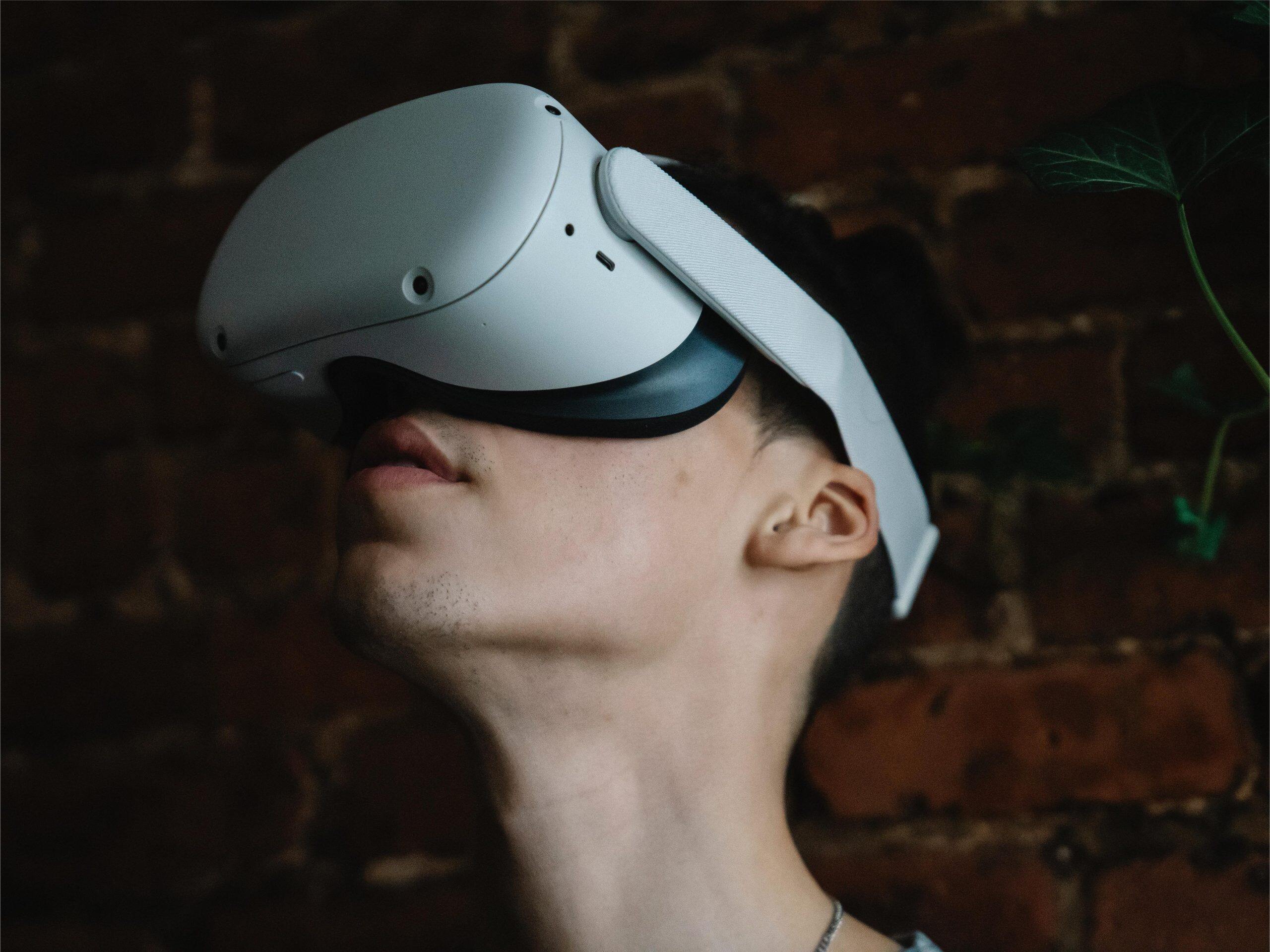Although the concept of the metaverse is still in the process of being continuously defined, there is a general consensus in the market that virtual humans play a key role in it.
From a medium to short-term perspective, related technologies of virtual humans are gradually being implemented, and the application scenarios continue to expand, which may be an initial attempt at the integration and upgrading of technology, content, and industry under the concept of the metaverse; from a long-term perspective, when technological advancements can achieve low-cost mass production, personalized customization, and full intelligence interaction of virtual humans, we believe that they are expected to be widely applied in multiple industries, in the form of digital avatars, AI symbiosis, etc., becoming the gateway connecting the virtual world and the real world.

Commercialization: Multi-dimensional value exploration of content consumption, product services, and efficiency tools.
►”Person” is content, the integration of virtual and reality upgrades the content industry consumption experience.
① Virtual Idols: The idol industry explores industrialization. Currently, virtual idols mainly operate through live streaming, with relatively diversified monetization methods. Compared with the business models of real and virtual idols, the production process of virtual idols from “character creation → matching” has the potential for standardization, which can reduce the cost of talent cultivation and facilitate the promotion of the model, while also partially weakening the risks of real-life behavior.
② Virtual Characters: IP form extension and content integration. In terms of IP extension, virtual characters interact directly with users through social community platforms, extending the life cycle with more diverse content carrying capacity, and at the same time, they have the potential for commercialization such as content embedding and social account cooperation. In terms of IP integration, the next generation of narrative methods in the metaverse may no longer be limited to a single content form, but provide users with an integrated experience centered on content.

►”Human” is the product and efficiency, with both technology and warmth.
① Product Experience: Deepen the brand foundation with digitalization and virtualization. Recently, many brands have started virtual marketing, with virtual spokespersons being one of the main forms. In the short term, brands may use the metaverse hotspot to reach young user groups, and in the long term, the “people, goods, and field” in the metaverse may refresh users’ brand experience through the integration of virtual and real.
② Efficiency Tools: Virtual employees enter the field, and the digital transformation of the industry accelerates. Virtual hosts explore automation in the production process from text to audio and video, reflecting the empowerment of technology in content production and media convergence; virtual anchors reduce the initial investment in corporate talent training costs, fill the gap in live broadcast talents, and can also share the workload of real anchors in operational efficiency, improving the efficiency of the live broadcast room; in terms of digital employees, flexibility, efficiency, and cost reduction are the main demands for enterprises and employees, and the promotion and popularization across industries are pending further improvement of related technologies.

From Virtual Beings to the Metaverse:
① Digital Avatars and Virtual Identities: The technology of digital avatars is becoming more prevalent, and the popularity of virtual social interactions is on the rise. However, overall, it is still in its early stages, with significant room for development on the technical front and the need for further clarification and improvement on the institutional level.
② Tool Needs and Emotional Needs: We believe that at this stage, the application of virtual human tools is still centered around “substitution and alternatives.” Looking to the future, virtual humans, due to their blend of virtual and real characteristics, are expected to become an interface between the metaverse and the real world, providing even greater value.

The virtual human industry continues to heat up, and the virtual human is re-discussed from the perspective of the metaverse. Although the metaverse is still in the process of expanding its definition, the market has reached a certain consensus on the key role of virtual humans in it.
In the past six months, cases of virtual humans have continued to emerge, and the industry has explored on the technical and application levels. This report will further analyze the commercial capabilities of different types of virtual humans, and discuss the potential value and development path of virtual humans based on the concept and framework of the metaverse.
Ⅰ. What is a virtual human?
Broadly speaking, a virtual human refers to a virtual image that exists in a virtual form and has anthropomorphic characteristics.
In terms of characteristic definition, a virtual human needs to imitate humans in dimensions such as appearance, personality shaping, and interactive expression. On the technical level, the production process of a virtual human includes appearance presentation technology, including modeling rendering, motion capture, VR/AR, etc., as well as interactive expression technology, including natural language processing, voice interaction and other artificial intelligence technologies.
Among them, based on whether the virtual human behavior is fully intelligent, it can be further divided into real person-driven virtual humans and AI-driven virtual humans.
At the application level, the current virtual humans are mainly direct to C-end applications such as virtual idols and virtual KOLs, and are gradually expanding to B-end scenarios such as virtual employees and virtual assistants. Integrating recent industry perspectives, virtual humans can be measured and evaluated in terms of anthropomorphism, interactivity, intelligence, and openness from four aspects.
Chart 1: Virtual Human Definition: Characteristics, Technology, and Application
01 Revisiting Virtual Beings: Pioneers of the Metaverse
II. How to view the positioning of virtual beings in the metaverse?
Medium and short-term perspective: Virtual being technology is gradually being implemented, and the application scenarios continue to expand, which may lay a foundation for the development of the metaverse.
From the overall market trend, thanks to the optimization of virtual being supply and the increased attention to the concept of the metaverse, the virtual being industry has been continuously heating up since 2021.
According to the calculation of the Speed Metaverse Research Institute, in 2022, the market size of virtual beings increased by 64.5% year-on-year, reaching the peak growth rate in recent three years, and there is a large growth space in the future.

From the perspective of the industrial chain, the virtual human industry revolves around the technical production, application operation, and user/customer reach of virtual humans. The number of related companies is rising rapidly, with nearly 170,000 virtual human-related enterprises in China by 2021.
From the perspective of industry applications, thanks to the progress in technologies such as modeling rendering, motion capture, and artificial intelligence, the application of virtual humans has been frequently implemented recently, with a growing diversity in style and scenarios.
As an innovative form of the integration of virtual and reality, virtual humans can be seen as an initial attempt at the coordinated upgrade of technology, content, and industry under the concept of the metaverse. The industry is expected to use this as a starting point to gradually increase the acceptance and tolerance of related concepts and applications, and promote the gradual release of value of the metaverse at the levels of users, enterprises, and society.
Chart 2: The virtual human industry chain is centered around production, operation, and reach.
Chart 3: Partial layout of virtual human industry chain companies

Long-term Perspective: Virtual humans are one of the key components of the metaverse and are expected to lay the foundation for the construction of virtual identities in the metaverse.
In the short term, the application value of virtual humans still revolves around the trend of online transformation of offline scenarios, which can be seen as a continuation of existing business models. Looking forward to the metaverse, when technological advancements can achieve low-cost mass production, personalized customization, and fully intelligent interaction of virtual humans, virtual humans are expected to be widely applied in various industries, in the form of digital avatars, AI symbiosis, etc., becoming the gateway connecting the virtual world and the real world, and releasing value at the intersection of culture and technology.
Chart 4: Looking forward to the metaverse: Virtual humans may lay the foundation for digital avatars and digital assets.
I. “People” as Content, Integrating the Virtual and the Real to Enhance the Consumer Experience of the Content Industry
From the Real to the Virtual: Industrialization Attempts in the Idol Industry
Virtual idols primarily operate through live streaming, with relatively diverse monetization methods.
In terms of business operations, most virtual idols currently appear in social community platforms in virtual form, and the performers (also known as “the person inside”) interact and communicate with users through live streaming.
In terms of commercial monetization, live streaming rewards, advertising marketing, peripheral derivatives, and performance activities are all potential monetization methods.
Chart 5: Virtual Idol Operations and Business Model: Live Streaming as the Main Form, Diverse Monetization Methods
The business processes of virtual idols and real-life idols are similar, but there are differences in business logic and commercial focus.
Comparing the business models of virtual idol operation company ANYCOLOR (NIJISANJI) and real-life idol agency Yuehua Entertainment, the similarities between the two are: both companies start with talent scouting and cultivation, and then realize monetization through team commercial operation.
Differences lie in:
1) Talent Discovery Logic: ANYCOLOR’s virtual idols are created by the technology and creative team to set character settings and virtual appearances, and then select the appropriate “inner person” from long-term recruitment; while Yuehua Entertainment’s real-life idols start with talent selection and then enhance their business capabilities through a longer period of training.
2) Commercial Monetization Logic: Virtual idols establish strong private domain channels and value through high-intensity real-time interaction with users, and their monetization methods are mainly focused on the C-side. In contrast, domestic real-life idols mainly gain exposure through public media and monetize primarily through the B-side, including attending business activities, performing in film and television productions, and participating in variety shows.
Chart 6: Comparison of business models between virtual idols and real-life idols

Chart 7: ANYCOLOR Revenue Structure: Virtual Idols Mainly Monetize through C-end (Consumer-end) Revenue.
02 Commercialization: Exploring the multidimensional value of content consumption, product services, and efficiency tools.
Chart 8: Yuehua Entertainment Revenue Structure: Domestic real-life idols mainly monetize through B-end.
Virtual idols “transform from reality to virtuality,” which can be seen as an attempt by the idol industry to resolve issues such as dependence on top talents and external risks.
►Partial standardization and virtualization of the production process, shifting from top talent dependence to industrialized production.
• Talent cultivation level: Real-life idols require a higher initial investment, while virtual idol teams have a larger creative component.
According to the company’s announcement, trainees at Yuehua Entertainment need to undergo three years of professional training to become officially signed artists. During this process, the company bears all the training-related expenses, the initial chain is longer, and there is a risk of sunk cost.

Compared to the full-process training model of real-life idols, the virtual idol model of “character creation → matching” reduces the emphasis on real people and focuses on the “character”. On the one hand, it lowers the threshold for virtual idols, shortening the talent cultivation cycle and resource investment in the early stage. On the other hand, it also enhances the company’s control over the virtual idol IP.
• Model promotion level: The production of virtual idols is easier to standardize and has greater potential in mass production and regional promotion.
1) Mass production: Due to the high difficulty in cultivating real-life idols, the number of artists launched each year is limited, which is prone to the risk of head dependence.
In comparison, the operation process of virtual idols is more similar to the production of content IP, with a certain potential for mass production. Companies can increase user preference coverage through diversified character and appearance settings, and also reduce the company’s dependence on a single artist.
2) Regional Promotion: The advantage of virtual idols lies in the team’s ability to adjust the design of the virtual image to cater to the aesthetic differences of users in different regions. In addition, compared to film and television works, programs, etc., the content carrying capacity and universality of live broadcasts are stronger. At the same time, the company can also resolve cultural differences by recruiting local “people inside.”
Chart 9: Rainbow Community Virtual Idol Production: Standardization and virtualization, with mass production potential and regional promotion capabilities.
►Reducing Real Person Behavior Risk, minimizing the impact of changes in external objective conditions on business. In terms of behavior risk, the uncertainty factors related to real person behavior are partially reduced because the team usually keeps the identity of the “person in the middle” confidential. At the same time, virtual idols mainly focus on online activities, which are relatively less affected by external environments, allowing for high-frequency and high-intensity interactions with users.
From Virtual to Real, IP Form Extension and Content Integration
Vertical extension, virtual humans empower the role to become an IP through social community platforms. We believe that the transformation of media channels has endowed content IPs with more forms, and virtual humans can be regarded as one of the innovative forms among them.
►From Virtual Characters to Virtual People: “Stepping out” of the work to interact directly with users on social community platforms. We believe that content types with a higher degree of fiction, such as comics, animations, and games, are expected to leverage social platforms to realize more possibilities of IP.
►Commercial Potential: A longer life cycle and more diversified monetization value.
From the perspective of the life cycle, as virtual characters gradually “independent” from their original content forms and exist in the form of virtual people, their flexible content evolution may better adapt to the changes in user preferences, releasing value over a longer period of time.

From a commercialization form perspective, compared to virtual characters, virtual humans have a wider range of potential commercial forms due to their diverse channels for reaching users, including content embedding, social account cooperation, and live performances.
Horizontal integration, virtual humans initiate experiential storytelling from a metaverse perspective. The next generation of storytelling in the metaverse may no longer be limited to a single form of content such as film and television or games, but instead, it will focus on content and provide users with an integrated experience.

“Virtual humans themselves are a product of the combination of form.”
“At the level of media channels, virtual humans can reach users through multiple means, including online social networks, live streaming platforms, and offline holographic projections.”
“In terms of content form, virtual humans are an intermediate product between online and offline forms of IP. They exist in fictional works and can also interact with the real world.”
Recently, there have also been virtual human IPs that integrate various forms of content. Japanese companies Avex, Kodansha, and Dai Nippon Printing have jointly launched a virtual artist IP called “Fifteen Girls,” with Avex in charge of music, Kodansha in charge of novels, and Dai Nippon Printing in charge of virtual space.
► Virtual beings bring the virtual world to life.
• On the content level, “people” are one of the key elements in building the world. Narratives are developed through character relationships, and the world is built on the basis of narratives.
Taking Disney as an example, its virtual characters have a long operation cycle and evolve into various forms during the process. The character matrix becomes a theme park offline, and new works can also be created online.
• On the technical level, if virtual characters can achieve real-time intelligent interaction with users with the help of technologies such as AI, users will have a more realistic experience.

II. “People” as Products and Efficiency, with Technology and Warmth
The potential for B-end applications of virtual humans is significant, and the market structure is expected to evolve from a content-focused approach to a balanced focus on both content and tools.
There are two main values of virtual humans in B-end applications: Externally, virtual humans are expected to help companies provide better product access and service experiences to their customers; Internally, virtual humans may reduce the waste of human resources in repetitive work and enhance work efficiency and quality as a concrete form of digital systems.
Chart 9: Applications and cases of B-end virtual humans: The virtual human market evolves from content-oriented to tool-oriented.

Product Experience: Virtual humans provide better product accessibility and service experience.
In the short term, leveraging the “Metaverse” topic for marketing, and in the long term, deepening the brand foundation with digital and virtual product services. Since 2021, many brands have carried out “Metaverse” themed marketing, mainly in the following forms:
1) Enabling or launching virtual spokespersons;
2) Releasing digital collections;
3) Holding online virtual product launches, opening online exhibition halls, etc. We believe that the main driving factors include:
Chart 10: The rise in brand “Metaverse” themed marketing heat.

Short-term: Hot topics help brands reach young user groups.
Topic level, since 2021, the concept of the metaverse has been continuously heating up, and the public has been discussing the definition and elements of the metaverse, which has driven the attention of brands to virtual marketing, including virtual characters.
User level, young groups have developed with the Internet and have a good acceptance of virtual culture. We believe that young users have attention to virtual culture, and innovative activity forms in virtual fields may help brands gain attention.
Medium and long-term: The integration of virtual and real worlds refreshes users’ brand services and experiences. **Under the concept of the metaverse, brands have opportunities to provide better products and services to users in the three dimensions of “people, goods, and place”. According to IDC forecasts, by 2023, 60% of companies may provide immersive experiences to users, achieving differentiation through interactive methods that simulate offline physical feelings and solving users’ digital fatigue.
Chart 11: The possibility of brands in the metaverse to “people, goods, and place”.

• At the “Human” Level: Virtual humans can become a direct channel for brands to communicate with users, providing “warm” services to users.
1) Embodiment of Brand Image: Brand virtual spokespersons can amplify brand characteristics through appearance and operation, and their relatively fixed image also provides an anchor point for user cognition and long-term emotional accumulation. Currently, many brands, including Yili, Florasis, Watsons, and KFC, have launched their own virtual spokespersons.
2) Warm and Trustworthy Services: Although robots or automated systems have been able to improve service efficiency, in some scenarios, such as financial services and healthcare, communicating with a “human” is still an important consumer experience.

With the advancement of technologies such as AI, VR/AR, virtual sales and customer service may be able to provide personalized consulting and explanation services to users. Many internet companies have launched virtual customer service solutions, such as China Mobile’s mobile cloud launching a virtual customer service and NetEase Yunxin also launching a virtual customer service solution for the financial industry.
• On the “goods” level: Virtual goods extend the brand IP and convey brand value. At present, digital collections are one of the important forms of virtual goods for brands, because they have characteristics such as uniqueness, permanence, non-replicability, and non-divisibility, which enhance the brand’s social currency attributes in the virtual field and link the brand image with the user’s identity.
Looking forward, brands are expected to further interpret the value of “goods” in the metaverse by strengthening the connection between virtual and physical goods and exploring the “practical effects” of virtual goods.
• At the “Field” Level: Recreate offline experiences and pursue the brand’s “permanent online” presence. The integration of the virtual and the real under the concept of the metaverse goes beyond merely replicating offline activities on a formal level. It can also unlock value in the way brands interact with users and the interactive experiences they provide:
1) Brand Exposure Level: Brand advertising content may be more naturally integrated with users’ online activities. NetEase’s mobile game “Justice Online” has disclosed that the game may monetize through advertising by embedding ads in the game’s original scenes. For example, when a user’s virtual avatar drinks water in the game, the bottle will display the brand logo.
2) Brand Interaction Level: Experience “physical” stores in a virtual field. Baidu’s virtual world “Xirang” provides brands with virtual fields to open digital exhibition halls and settle in commercial streets. Currently, brands from industries such as automobiles, fashion, and consumer goods have landed in the “Blue Universe” cyber commercial area of “Xirang.”
Opening “physical” stores in a virtual field may be the first step for brands to recreate offline consumer experiences. In the future, with technological upgrades, brands may be able to achieve “permanent” business operations in virtual fields.
Chart 12: Brands may embed advertisements in the original scenes of the game.
Chart 13: Brands Set Up Online Virtual Shopping Streets
Efficiency Tools: Virtual Humans Promote Industry Digitalization Upgrade
The entry of virtual employees accelerates the digital transformation of enterprises. AI-driven virtual humans have application potential in multiple industries, with artificial intelligence and other related technologies as the driving factors. In the “Top 10 Predictions for China’s Artificial Intelligence Market in 2021” by IDC, it is mentioned that by 2024, 45% of repetitive work tasks will be automated or enhanced by “digital employees” supported by AI, robots, and Robotic Process Automation (RPA).
Recently, there have been some application cases in certain industries. For example, Cui Xiaopan, a virtual employee in the financial department of Vanke, has achieved a document verification rate of 91.4%; the virtual coach Guan Jun has helped the Chinese ice and snow national team win gold in the 2022 Beijing Winter Olympics with an intelligent sports analysis model.
Chart 14: Rich application scenarios for artificial intelligence solutions.

Virtual Hosts: Automation of the production process from text to audio and video. During the National People’s Congress (NPC) and the Chinese People’s Political Consultative Conference (CPPCC) sessions in 2022, several virtual hosts participated in the reporting work, including the virtual anchor “AI Wangguan” launched by Yangshipin.
“AI Wangguan” is highly consistent with its prototype (Wangguan, the financial host of the Central Broadcasting Station) in terms of expression and voice, and can complete processes such as data collection, trend analysis, visualization packaging, and virtual human broadcasting with the support of technical and content teams.
Virtual hosts have broken through the physiological and physical limitations of real people, improved the timeliness of information transmission, and reflected the empowerment of technology in content production and media integration.

Virtual Anchors: Enhancing efficiency from anchor talent cultivation to live broadcast room operation.
• Talent Cultivation: Virtual humans may address the shortage of anchor requirements in functional live broadcast scenarios. According to iResearch Consulting, the demand for live broadcast talents in China in 2022 is 15 million people, a year-on-year increase of 25.0%.
In terms of e-commerce live broadcast scenarios, anchors need to be cultivated in aspects such as character setting, professional knowledge, and oral expression. For small and medium sellers or businesses, the initial cost investment is relatively high, and there is also uncertainty in anchor attrition in the later stages. The AI virtual human solution, which can be purchased and used immediately, reduces the risk of sunk cost and may be a better solution.
• In terms of operational efficiency, AI anchors share the workload of human anchors and fill in the efficiency gap. In addition to going live, the work content of e-commerce anchors also includes preparing live content, equipment debugging, product selection, and reviewing the live broadcast, which is quite intensive.
In the future, functional scenarios such as e-commerce live broadcasting may form a model of human anchors + AI anchors, with real people forming the IP of the live broadcast room, supplemented by AI to improve efficiency. Several brands have already started using AI live broadcasting models, and platforms such as Blue Focus and iFlytek have also launched virtual live broadcast rooms, virtual anchor products, and other services.
Chart 15: There is a large demand for live broadcast talents in China.
Chart 16: Virtual anchors share the workload of real anchors and fill the gaps in efficiency.
►Digital Employees: Efficiency and flexibility are the main demands, with the need for further technological upgrades. According to a survey by iiMedia Research, most users believe that the advantages of digital employees lie in reducing labor costs and improving work efficiency through round-the-clock operation. However, the current shortcomings are mainly limited problem-solving capabilities and a relatively rigid process.
SenseTime’s Smart Industry Research Institute has classified virtual humans on two dimensions: automation and anthropomorphism. Virtual humans at level L1 are mainly flat images and lack interactivity and intelligence, while virtual humans at level L5 can undertake personalized work and achieve fully intelligent interaction. SenseTime believes that the promotion and popularization of virtual humans across industries can only be achieved when the industry develops to levels L4 and L5.
Chart 17: Efficiency and flexibility are the main demands of users for digital employees.

I. Digital Avatars and Virtual Identities: Can Virtual Humans Help Users Transition from “Online” to “Present”?
The technology of digital avatars is becoming more prevalent, and the popularity of virtual social interactions is on the rise. In terms of technological tools, several companies have recently launched platforms or tools for creating digital avatars, including BlueFocus’s “Avatar Creation”, iFlytek’s “AI Virtual Human Live Broadcasting System”, and Happy Cloud’s “Cloud-Native Digital Human Solution”.
In terms of application scenarios, the use of digital avatars is still mainly concentrated in the fields of entertainment and social interaction, with a significant increase in the popularity of virtual social interactions. According to data.ai statistics, the global downloads of virtual avatar social apps in the first quarter of 2022 increased by 60% compared to the first quarter of 2021, and grew by 215% compared to the first quarter of 2020. Many domestic internet companies have also launched virtual social activity platforms, expanding the application scenarios of digital avatars.
Chart 18: Comparison of Virtual Social Activity Platforms under NetEase, Tencent Music, and Baidu.

Technical Aspect: Currently, virtual beings have significant room for improvement in terms of quality, cost, and user experience, and are at a stage where they are mutually restrictive. Virtual beings are currently in the process of transitioning from “exhibitions” to “products,” moving from the significance of display and promotion to actual use value and commercialization effects.
Institutional Aspect: There is no clear system in place to regulate digital avatars and the virtual identities they represent. Issues that need to be discussed include: how to supervise the behavior of digital avatars in virtual domains, how to define responsibility; the connection and parallel criteria between virtual identity and real identity; whether highly immersive online domains will lead to changes in human behavior and psychological impact, etc.
II. Instrumental and Emotional Needs: Can Virtual Humans Achieve Technology for Good?
Instrumental Needs: Virtual humans bridge the gap between the virtual and real worlds. At present, the application of virtual human tools is still centered around “substitution and alternatives,” that is, exploring in directions of repetitive labor or work with physical limitations.
Looking to the future, virtual humans, with their characteristic integration of virtual and real elements, are expected to become an interface between the metaverse and the real world: On one hand, users can connect online and offline activities through the transformation of virtual and real identities; On the other hand, applications and services that currently exist in the form of mobile internet products and digital systems may further interact with virtual humans in the future, helping technology to achieve empathy with users.
Emotional Needs: Virtual humans provide companionship, care, and other humanistic considerations. With the development of artificial intelligence technology, the understanding, expression, and interaction of virtual humans are expected to be further enhanced, thereby unlocking value in human emotions and perception.
Risk Warning
The progress of virtual human technology is not as expected. Technology is one of the key drivers of the development of the virtual human industry. If the key technologies of virtual humans fail to continue upgrading, and the technical usage threshold cannot be effectively reduced, resulting in production costs remaining at a high level or the quality and functionality of virtual humans being limited, it will affect the expansion of virtual human application scenarios, as well as the realization of market and user demand.
The commercialization process of virtual humans is not as expected. On the C-end level, if virtual humans cannot continue to optimize in terms of appearance and operation, or if the operation team cannot maintain a good cooperative relationship with the virtual human performers, it may lead to a decrease in users’ willingness to pay and the suspension of virtual human operations. On the B-end level, if the functionality of virtual humans cannot be further improved and costs continue to decrease, it may be difficult for virtual humans to continue to explore the market.
Legal system and industry standard risks. The laws and regulations for the virtual human industry are still to be improved. On the one hand, the legal subject definition between virtual human IP and real human drivers is not yet clear. If illegal and non-compliant behaviors occur, it may lead to a problem of unclear responsibility subjects. At the same time, the connection between virtual human practitioners and virtual human IP, as well as issues of interest distribution, need to be regulated by more perfect legal systems and industry standards.
Ethical and Moral Risks. The industry is still continuously discussing the mental and behavioral aspects of humans in the virtual world. There are no established codes of conduct and ethical standards for people using virtual avatars for social interactions and production activities. The relationship construction between real people and AI-driven virtual humans is still in the exploration stage. If ethical and moral issues arise in the application of virtual humans, it may lead to the interruption of industry development.
Asset Ownership and Privacy Data Risks. In terms of asset ownership, virtual humans, as a form of digital assets, face serious issues of unclear copyright boundaries and piracy infringement. If the industry fails to address the authorization and rights protection issues of virtual humans through technology and policies, their profitability may be compromised. On the level of personal privacy protection, the construction of virtual humans, especially digital avatars, relies on the input of users’ appearance, identity, and other data. Individual privacy data, as the underlying source of virtual humans, may face risks of excessive collection and data leakage.













